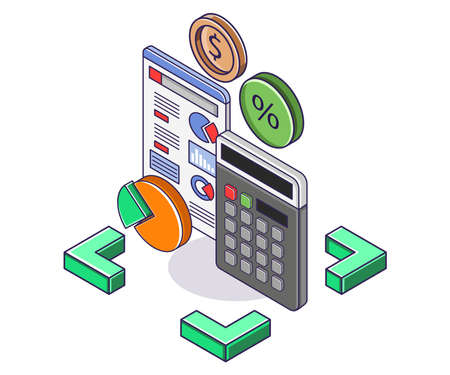Understanding Stock Market Volatility in America
Stock market volatility is a fundamental aspect of the U.S. financial landscape, shaping the investment strategies of millions of Americans. In essence, volatility measures how much stock prices fluctuate over a given period, often represented by indices like the VIX, known as the “fear gauge.” While some degree of volatility is normal and even healthy for market growth, significant swings can trigger panic or opportunity, depending on an investor’s approach.
Several factors typically ignite market swings in the United States. Macroeconomic indicators—such as inflation rates, employment data, and Federal Reserve policy announcements—can send shockwaves through equity markets. Geopolitical tensions, trade disputes, and unexpected global events (like pandemics) also play a pivotal role. Additionally, earnings reports from major U.S. corporations or sector-specific news can spark sharp reactions among traders and investors alike.
Recent history offers multiple high-profile examples of crises that have rocked American markets. The 2008 financial crisis saw unprecedented levels of volatility as major banks failed and the housing bubble burst, leading to massive sell-offs across Wall Street. More recently, the COVID-19 pandemic in early 2020 resulted in one of the fastest bear markets in U.S. history, with daily double-digit percentage swings becoming commonplace. Even tech-driven events—like the GameStop short squeeze fueled by retail investors on Reddit—have demonstrated how quickly sentiment can shift and volatility can spike.
Understanding these triggers and historical precedents is crucial for investors navigating turbulent times. In subsequent sections, we’ll explore how passive and active investors react differently when volatility surges and crises unfold in American markets.
2. Defining Passive and Active Investment Strategies
When discussing how investors respond to market volatility, it’s crucial to understand the fundamental differences between passive and active investment strategies. In the American financial landscape, these two approaches represent distinct philosophies with unique risk profiles, cost structures, and behavioral tendencies during crises.
Passive Investment Strategies
Passive investing aims to replicate the performance of a specific market index, such as the S&P 500 or Nasdaq Composite. Common vehicles include index funds and exchange-traded funds (ETFs). Rather than attempting to “beat” the market, passive investors accept market returns, focusing on long-term growth and minimal transaction activity. This approach is popular among Americans seeking low fees, broad diversification, and hands-off portfolio management.
Active Investment Strategies
In contrast, active investing involves frequent buying and selling of securities based on research, forecasts, or market timing. Active investors—often through managed mutual funds or personal stock picking—aim to outperform market indices by identifying mispriced assets or capitalizing on short-term trends. While this strategy can offer higher potential returns, it typically comes with greater risk, higher costs, and more intensive oversight.
Key Differences Between Passive and Active Approaches
| Strategy Type | Common Products | Main Goal | Typical Costs | Investor Profile |
|---|---|---|---|---|
| Passive | Index Funds, ETFs | Track Market Index | Low Fees | Long-term, Risk-Averse |
| Active | Managed Funds, Stock Picking | Outperform Market Index | Higher Fees | Short-term Focused, Risk-Tolerant |
How Americans Typically Choose Between Them
The choice between passive and active strategies often depends on an investor’s risk tolerance, investment horizon, and confidence in their ability—or their advisor’s ability—to predict market movements. In recent years, a growing number of American investors have favored passive investing due to lower fees and consistent long-term results. However, some still prefer active management during turbulent times for its potential to avoid losses or capitalize on short-term opportunities.

3. Common Reactions of Passive Investors During Market Crises
When the U.S. stock market faces turbulence, passive investors typically follow a disciplined approach, often described as “staying the course.” This reaction is deeply rooted in historical data and time-tested investment philosophies, particularly the Boglehead approach—named after John Bogle, founder of Vanguard and pioneer of index fund investing. The Boglehead philosophy emphasizes low-cost, diversified investing, minimizing emotional trading decisions, and sticking to a long-term plan regardless of short-term volatility.
Embracing Dollar-Cost Averaging
One key principle passive investors rely on during crises is dollar-cost averaging (DCA). Instead of trying to time the market or make large trades based on fear or speculation, these investors continue to invest a fixed amount at regular intervals—whether the market is up or down. This steady approach allows them to purchase more shares when prices are low and fewer when prices are high, smoothing out overall cost over time. Historically, DCA has helped reduce the impact of market swings and encouraged consistent participation in the market.
Historical Resilience: Learning from Past Downturns
U.S. market history shows that periods of high volatility—such as the 2008 financial crisis or the COVID-19 crash in early 2020—have tested investor resolve. However, data consistently demonstrate that those who maintained their passive strategies, rather than making panic-driven moves, were better positioned for recovery when markets rebounded. For example, studies by Vanguard reveal that investors who held onto their diversified portfolios during major downturns not only avoided locking in losses but also benefited from subsequent market recoveries.
Cultural Attitudes: The American Investor Mindset
Within the U.S., passive investing has become increasingly popular as more Americans recognize the difficulty of consistently beating the market through active trading. Culturally, there is a growing acceptance that patience and discipline—rather than reactive decision-making—are essential for long-term financial success. Passive investors often reference Warren Buffetts advice to “be fearful when others are greedy and greedy when others are fearful,” underscoring their commitment to remain invested despite headlines or short-term panic.
4. Common Reactions of Active Investors During Market Downturns
When stock market volatility spikes, active investors in the United States often display distinct behavioral patterns compared to their passive counterparts. Understanding these common reactions provides valuable insight into how individuals attempt to manage risk and opportunity during times of financial stress.
Increased Trading Activity
One of the most noticeable responses among American active investors is a surge in trading volume. As market uncertainty grows, many investors increase their buying and selling in an attempt to either cut losses or capitalize on perceived bargains. This behavior is frequently fueled by real-time news, social media sentiment, and short-term market forecasts.
Attempts at Market Timing
Active investors frequently try to time the market during downturns—selling positions early to avoid further losses or re-entering after believing the bottom has been reached. While this approach appeals to those confident in their analytical abilities, extensive research shows that even professional fund managers struggle to consistently predict market movements.
Behavioral Patterns Table
| Behavior | Description | Common Rationale |
|---|---|---|
| Panic Selling | Selling off investments rapidly during sharp declines | Avoid further losses and preserve capital |
| Bargain Hunting | Buying stocks perceived as undervalued after sell-offs | Capitalize on potential rebound opportunities |
| Frequent Portfolio Rebalancing | Adjusting asset allocations more often than usual | Manage risk exposure dynamically as conditions change |
| Following Market Trends | Mimicking prevailing investment flows (momentum investing) | Avoid being left behind by rapid market moves |
The Psychology Behind Active Decisions
The driving forces behind these actions are deeply rooted in investor psychology. Fear of loss (loss aversion), the illusion of control, and recency bias all play critical roles. The emotional stress of seeing portfolio values decline can lead to impulsive decision-making, while overconfidence may cause some investors to believe they can outsmart the market despite substantial evidence to the contrary.
Summary: Data-Driven Perspective for Investors
Data from recent U.S. market crises—such as the COVID-19 crash in March 2020—showed that heightened trading among active investors often led to suboptimal outcomes compared to staying invested. While active strategies may offer opportunities for gains, they also carry increased risk and emotional costs, highlighting the importance of a disciplined approach during periods of volatility.
5. How Media and Market Sentiment Drive Investor Behavior
In times of market crisis, the American news cycle, financial media outlets, and social media platforms play a crucial role in shaping investor sentiment—often amplifying both fear and opportunity. During volatile periods, headlines from sources like CNBC, Bloomberg, and The Wall Street Journal can trigger emotional reactions among investors, sometimes resulting in swift market moves. For example, during the COVID-19 pandemic’s onset in March 2020, continuous breaking news and dire forecasts led to widespread panic selling across U.S. markets. Passive investors, guided by long-term strategies, typically avoided rash decisions despite negative sentiment. In contrast, active investors frequently responded to daily news updates and market rumors by rapidly reallocating portfolios or moving to cash.
The Role of Financial Media
Financial television networks and online publications provide real-time analysis but can also contribute to herd behavior. When influential commentators highlight risks or opportunities, it often leads to increased trading volume and volatility. A case in point is the GameStop short squeeze in early 2021: coverage by mainstream financial media combined with viral discussions on Reddit’s r/wallstreetbets fueled a speculative frenzy among retail traders, demonstrating how quickly sentiment can turn into collective action.
Social Media Acceleration
Platforms like Twitter and Reddit have democratized market information but also accelerated the spread of rumors and emotional responses. Hashtags such as #StockMarketCrash or trending topics related to specific companies can sway investor perceptions within minutes. Active investors are more likely to act on these fast-moving signals, while passive investors remain relatively insulated due to their commitment to index-based strategies and infrequent trading.
Real-World Impact on Decision Making
Case studies show that during crises—such as the 2008 financial meltdown or the 2020 oil price collapse—media-driven sentiment has a measurable impact on trading patterns. Surveys indicate that up to 35% of U.S. investors admit making impulsive trades based on alarming news or viral posts during high-volatility events. For passive investors, however, adherence to systematic investing and regular rebalancing provides a buffer against the noise generated by sensational headlines.
Ultimately, understanding how media cycles influence both active and passive investor behavior is vital for navigating market turbulence with data-driven discipline rather than emotion-led reactions.
6. Lessons Learned: What History Teaches Us About Investment Approaches
Looking back at major U.S. market crises such as the 2008 financial meltdown and the COVID-19 crash, investors can draw key lessons on how different strategies perform under pressure. Historically, passive investors—those who stick with index funds or ETFs and avoid frequent trading—have often fared better during deep market shocks. For example, in both 2008 and 2020, panic selling led many active investors to lock in losses by trying to time the market or chase fleeting trends. Meanwhile, passive investors who stayed the course generally saw their portfolios recover as markets rebounded, reflecting the long-term growth trajectory of the U.S. economy.
Performance Analysis: Passive vs. Active During Crises
Data from these crises show that active management rarely delivers consistent outperformance during periods of extreme volatility. The S&P Dow Jones Indices SPIVA reports consistently reveal that most actively managed funds underperform their benchmarks over longer periods, especially after factoring in higher fees and transaction costs. In contrast, passive investment vehicles like low-cost index funds not only provide broad diversification but also remove emotional decision-making from the equation—a crucial advantage when headlines are fueling fear.
Cultural Context: The American Investor Mindset
The American investing culture values resilience, patience, and a data-driven approach. While its tempting for investors to react quickly in a crisis—mirroring broader cultural themes of taking action—history shows that disciplined patience often wins out over impulsive moves. Americans who adopted a “buy-and-hold” mentality during volatile times ultimately benefited from market recoveries, reinforcing the importance of focusing on long-term goals instead of short-term noise.
Key Takeaways for U.S. Investors
- Stay Invested: Attempting to time the market typically leads to missing key recovery days.
- Embrace Diversification: Index-based investing spreads risk across sectors and companies, buffering individual losses.
- Control Costs: Lower fees in passive strategies mean more money stays invested for compounding growth.
In summary, history teaches us that while active investors may occasionally outperform during brief windows of volatility, most American investors are better served by sticking with a passive, diversified strategy—especially during periods of extreme uncertainty. Letting data and discipline guide decisions is not just smart investing; it’s a reflection of enduring American values in finance.


